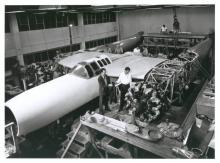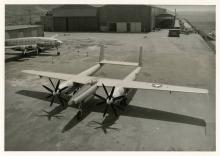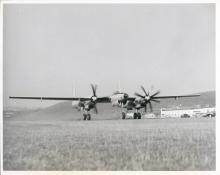Collection Paragraphs
XF-11 The Plane that Nearly Killed Him

Hughes: I don't like this page at all. I think this page is misleading. I suggest that in place of the first sentence you say something like the following:
With respect to all the airplanes which Hughes had designed and built - going clear back to his very first airplane, the H-1 - he had followed a rigid policy of making the flying tests himself. When questioned about this he always said, "If I have made a mistake in the design, then I'm the one who should pay for it, and I certainly would not ask somebody else to fly the plane if I were afraid to do it myself."
When we move into the second sentence on page 210, I want to suggest that we delete what we have here completely, and that a scrutiny be made of my testimony with respect to this incident, which was made before the Air Force Board of Inquiry. We have this somewhere. Miss Henley can probably dig it out. I'm not talking about the Senate testimony. In other words, I say that you should dig out my testimony which I made before the Board of Inquiry down here in Los Angeles.
I notice here that in the later pages you have cited the Air Force conclusion that it was pilot error, etc. I read the conclusion of this Board of Inquiry very carefully, and I don't think it was quite what we have summarized here. Secondly, I think that it was a very partial and unfair conclusion, which I protested at the time.

I don't say that my version and testimony should prevail over the conclusion of this Board. But, likewise, I don't think it fair to say that this was an impartial board; there were very strong indications that this Board did not make a careful study of the accident. There was a great deal of evidence which was not available at the time this conclusion was reached. In fact, the Board if Inquiry was composed of a group of young officers who were jealous, in the first place. Secondly, as I say, they didn't have the facts. There was a strong doubt in the minds of the officers on this Board as to whether there had really, in fact, been a malfunctioning of the propeller. Their entire conclusion, as I say, was one which I feel was loaded with partiality, and I think that one factor influencing this report of this Board of Inquiry was that the government had an enormous amount of money in this super hydromatic propeller which was on this airplane. And the Air Force certainly did not want to see the establishment of any proof that this propeller actually was a failure or malfunctioned.
Now I feel there is no question but what had an impartial Board of Inquiry met on this matter after it was thoroughly proven that this propeller was, in truth, defective, that then the result would have been quite different. Because the theory, that I should have known that this dissymmetry in the airplane's flight tendencies and attitude was caused by the propeller, and by some other structural failure. That theory is a very, very thin one, because with a dual rotation propeller and only half of the propeller in reverse - not all of it - it was very obvious that all instruments indicated the power plant and the propeller to be functioning normally. And I just don't think that a more thorough scrutiny of this matter would lead anyone to the conclusion that the pilot had any rhyme or reason or opportunity to believe that the trouble was caused by the propeller.

And I think, Steve, if you want to give this fair treatment you ought to consider my testimony as being pretty damned accurate, because I was the only one there; and I think later evidence pretty well showed that it was accurate, otherwise I'm sure the Air Force never would have permitted me to fly the second F-11.
Just a couple of points here to illustrate what I feel we're off the beam a little bit. You say, "He was trying to peer at the plane's under carriage when he lost control entirely." Hell, there was no loss of control. The airplane was completely under control right up to the time it hit the house. There never was a semblance of any stall or spin or anything of that kind at all. It was just a matter of a steady loss of altitude, due to the fact that this right propeller was in reverse, and the extreme throw of the controls, both the aileron and the rudder, was necessary to keep the plane from falling into a spin to the right. But there was never any slightest tendency - I wouldn't say tendency; naturally it wanted to all the time, but there was never any slightest indication that the airplane was out of control at any time. I mean its flight path and the way it contacted the houses, and the entire, well, all the facts involved, and the reports of all observers, and my report all confirmed that the airplane at no time went out of control.
Incidentally, later scrutiny of the X-Rays showed that I broke 24 ribs; every single rib, not eleven.
Stephen White deleted the story of the flight and crash of the XF-11 in the final article
